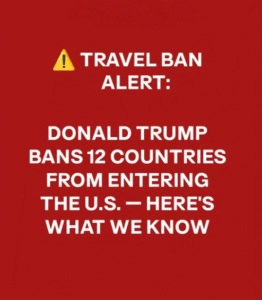Borders and Beliefs: The 2025 Travel Ban and the Architecture of Exclusion
On June 9, 2025, the United States drew a new line in the sand. President Donald Trump, in his second term, issued a proclamation that imposed a full suspension of entry—both immigrant and nonimmigrant—from 12 countries: Afghanistan, Myanmar, Chad, Republic of the Congo, Equatorial Guinea, Eritrea, Haiti, Iran, Libya, Somalia, Sudan, and Yemen. The move, reminiscent of his earlier travel bans, reignited debates about national security, immigration, and the soul of American identity.
But this wasn’t just policy. It was performance. A signal. A statement. A recalibration of who gets to come in—and who gets left out.
🧭 The Justification: Security or Spectacle?
According to the June 5 proclamation, the rationale was clear: national security. The administration cited high rates of visa overstays, unreliable vetting procedures, and the risk of admitting individuals who “espouse hateful ideology” or “bear hostile attitudes” toward American institutions. The language was familiar—echoing the rhetoric of Trump’s first term, when the so-called “Muslim Ban” sparked global outrage and legal battles.
This time, the scope was broader. The ban targeted not just Muslim-majority nations, but also countries in sub-Saharan Africa and the Caribbean. The message was unmistakable: America is tightening its gates.
But critics argue that the ban is less about security and more about symbolism. A way to project strength. To appeal to a base. To reassert control in a world that feels increasingly chaotic.
🌍 The Countries Named
The list of banned countries reads like a map of global instability. Many are grappling with civil war, authoritarian regimes, or humanitarian crises. Others have strained relationships with the U.S. or lack robust documentation systems.
- Afghanistan: Still reeling from decades of conflict and a fragile government.
- Myanmar: Accused of human rights abuses and political repression.
- Chad & Republic of the Congo: Cited for visa overstay rates and weak vetting infrastructure.
- Equatorial Guinea & Eritrea: Flagged for documentation issues and opaque governance.
- Haiti: Struggling with political unrest and natural disasters.
- Iran, Libya, Somalia, Sudan, Yemen: Longstanding targets of U.S. travel restrictions due to terrorism concerns and fractured state control.
The ban paints these nations with a broad brush—reducing complex societies to risk profiles.
🧠 The Human Cost
Behind every banned passport is a person. A student hoping to study in the U.S. A parent trying to reunite with family. A refugee seeking safety. A scientist invited to a conference. A child needing medical care.
The proclamation makes exceptions for diplomats, dual nationals, and those with pre-existing visas. But for many, the door is closed.
And that closure has consequences—not just logistical, but emotional. It sends a message: You are not welcome. You are not trusted. You are not part of the American story.
For international students, the impact is immediate. Some have reconsidered their plans to study in the U.S. Others fear deportation or visa denial. Universities, already grappling with declining foreign enrollment, brace for further disruption.
💼 The Economic Ripple
The American Immigration Council estimates that the ban could cost the U.S. economy billions in lost tuition, labor, and consumer spending. Many of the affected countries send workers to essential industries—healthcare, agriculture, construction. Others contribute to the tech and research sectors.
When borders close, so do opportunities.
And the ripple extends beyond economics. It affects diplomacy, cultural exchange, and America’s reputation as a beacon of possibility.
🔥 The Political Theater
Trump’s travel ban is not just policy—it’s performance. It’s part of a broader narrative about control, sovereignty, and the restoration of “law and order.” On the campaign trail and in office, Trump has condemned international students participating in protests, especially those related to the war in Gaza. The ban, in this context, becomes a tool of ideological gatekeeping.
It’s also a test balloon. The administration has asked 36 additional countries to comply with new vetting standards—or risk being added to the list. Most are in sub-Saharan Africa. The message is clear: conform, or be excluded.
This tactic—using immigration policy as leverage—raises ethical questions. Is it protection, or coercion? Is it security, or xenophobia?
🧵 The Fabric of American Identity
America has always been a paradox: a nation of immigrants that fears immigration. A land of opportunity that polices access. A melting pot that sometimes burns.
The travel ban forces a reckoning. Who gets to be American? Who gets to enter the conversation? Who gets to dream here?
For many, the ban feels like a betrayal of the country’s founding ideals. For others, it’s a necessary safeguard. But beneath the debate is a deeper truth: borders are not just physical. They are psychological. They shape how we see ourselves—and each other.
🕊️ The Legal Landscape
Lawsuits are already brewing. Civil rights groups argue that the ban violates constitutional protections and international norms. They point to the chaos of Trump’s first travel ban—families stranded, visas revoked, protests erupting at airports.
This time, the administration has been more methodical. More prepared. But the legal challenges will come. And they will ask hard questions: Can fear justify exclusion? Can policy override humanity?
💡 What We Learn
From this travel ban, we learn that immigration is not just about movement—it’s about meaning.
We learn that security can be used as a shield—or a sword.
We learn that the people most affected are often the least heard.
And we learn that America’s identity is still being written—one proclamation, one protest, one passport at a time.


